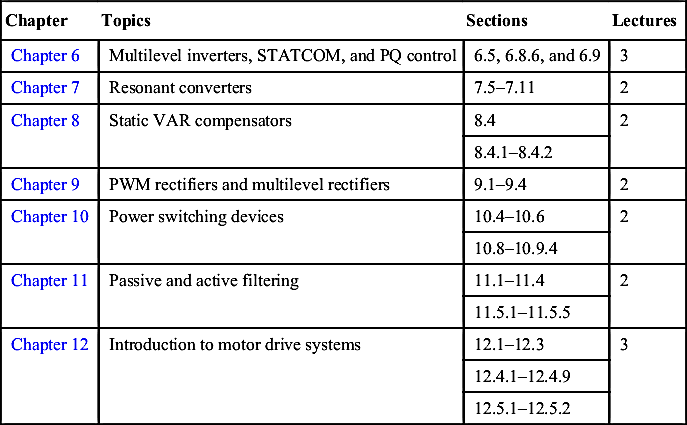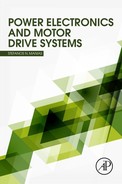Preface
This first edition of this textbook is designed specifically to facilitate teaching of the subject of power electronics and to provide information to electrical engineers who deal with different applications of power electronics. The book contains enough material to cover two undergraduate courses in power electronics. Selected sections from Chapters 1–12 cover topics for an introductory undergraduate course in power electronics, and selected sections from Chapters 7–12 cover topics for an advanced undergraduate or even graduate course.
Today electrical engineering students and electrical engineers in general are facing with some problems of understanding the subject of power electronics. The major reason is that some of the currently available textbooks are focused on the basic knowledge or the so-called early generation of power electronics technology, and some are focused on the so-called modern power electronics technology ignoring the basic knowledge of how to analyze power electronics circuits. Moreover, most of these textbooks do not include some additional material, which is needed for the analysis, and the reader has to refer to other textbooks. To be able to understand in depth the power electronics technology a textbook should provide material that covers the analysis of power electronics circuits and at the same time to be informed on the state-of-the-art of power electronics power conversion technology. Actually, this has been the motivation for writing this textbook. This textbook initially presents all necessary basic material to be able to analyze power electronics circuits in depth, i.e., basic power semiconductor devices and basic power converters. Next, the state-of-the-art power semiconductor devices and the state-of-the-art power electronics converters are presented and analyzed.
This book is intended to aid electrical engineering students in power electronics to overcome different difficulties by supplying detailed illustrations of the presented theory and 106 solved problems. The main role of the solved problems is to provide ways of thinking about problems, present methods of analysis, and develop strategies to critically evaluate the results. Moreover, the theory is reinforced by simulation examples using the well-known and widely available software programs, namely, SPICE, PSIM, and MATLAB/SIMULINK.
The contents of this textbook are divided into the following eight parts:
• Part 1, which includes Chapter 1, introduces the scope and applications of power electronics technology.
• Part 2, which includes Chapters 2 and 3, discusses the basic analysis of power circuits and basic rectifier topologies that employ diodes and thyristors.
• Part 3, which includes Chapters 4 and 5, discusses diode and SCR rectifier topologies.
• Part 4, which includes Chapter 6 only, discusses two-level and multilevel inverter topologies including different state-of-the-art modulation and output voltage and current control techniques.
• Part 5, which includes Chapter 7 only, discusses the state-of-the-art dc to dc power conversion techniques including resonant converters.
• Part 6, which includes Chapters 8, 9, and 11, discusses passive and active filtering. Moreover, includes pulse width modulation rectifiers.
• Part 7, which includes Chapter 10 only, discusses the state-of-the-art of power semiconductor switches providing also some information of SiC semiconductor devices. The characteristics and the gating circuits of different power semiconductor switches such as bipolar junction transistors, insulated gate bipolar transistors, metal oxide semiconductor field effect transistors, integrated gate-commutated thyristor, MOS-controlled thyristors, and gate turn-off thyristors are presented and analyzed. Moreover, the analysis of switching power losses is presented together with the selection of a heat sink.
• Part 8, which includes Chapter 12 only, discusses the control of dc and ac motors. The ac motor control techniques include V/f constant control, direct torque control, and field oriented control.
Finally, Tables 1 and 2 present the suggested topics and the number of 3-h lectures needed for an introductory and an advanced power electronics course, respectively.
Table 1
Suggested Topics for an Introductory Course in Power Electronics
| Chapter | Topics | Sections | Lectures |
| Chapter 1 | Introduction | 1.0–4.0 | 1 |
| Chapter 2 | Circuits with switches and diodes | 2.1–2.11 | 1 |
| Chapter 3 | Thyristor and single-phase half-wave rectifiers | 3.1–3.6 | 1 |
| Chapter 4 | Diode rectifiers | 4.1–4.7 | 2 |
| Chapter 5 | Thyristor rectifiers | 5.1–5.4 | 2 |
| Chapter 6 | Inverters | 6.1–6.5 | 2 |
| Chapter 7 | dc–dc converters | 7.1–7.4 | 1 |
| Chapter 8 | ac voltage controllers | 8.1–8.3 | 1 |
| Chapter 10 | Power switching devices | 10.1–10.3 | 2 |

Table 2
Suggested Topics for an Advanced Course in Power Electronics
| Chapter | Topics | Sections | Lectures |
| Chapter 6 | Multilevel inverters, STATCOM, and PQ control | 6.5, 6.8.6, and 6.9 | 3 |
| Chapter 7 | Resonant converters | 7.5–7.11 | 2 |
| Chapter 8 | Static VAR compensators | 8.4 | 2 |
| 8.4.1–8.4.2 | |||
| Chapter 9 | PWM rectifiers and multilevel rectifiers | 9.1–9.4 | 2 |
| Chapter 10 | Power switching devices | 10.4–10.6 | 2 |
| 10.8–10.9.4 | |||
| Chapter 11 | Passive and active filtering | 11.1–11.4 | 2 |
| 11.5.1–11.5.5 | |||
| Chapter 12 | Introduction to motor drive systems | 12.1–12.3 | 3 |
| 12.4.1–12.4.9 | |||
| 12.5.1–12.5.2 |

..................Content has been hidden....................
You can't read the all page of ebook, please click here login for view all page.
